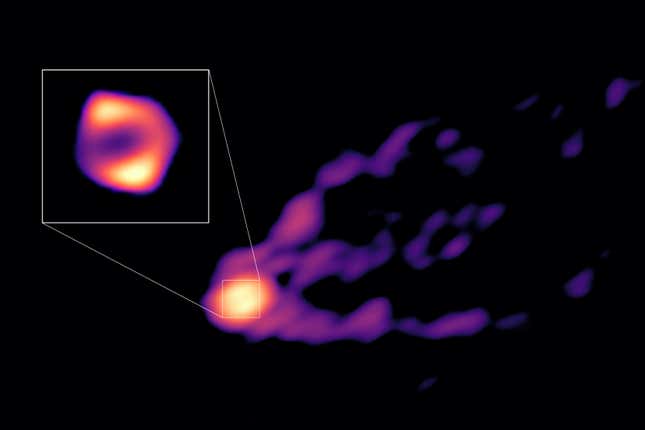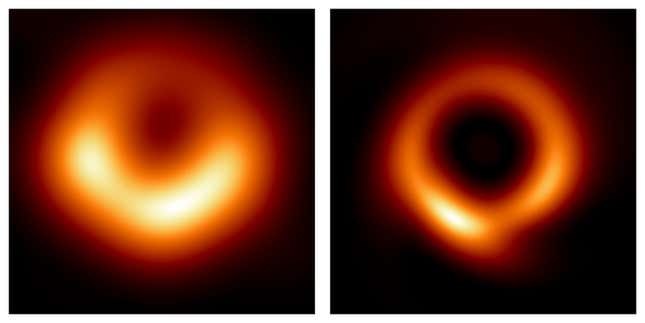New Image of M87 Black Hole Shows a ‘Fluffier’ Ring and Its High-Speed Jet
A team of researchers using the Global Millimeter VLBI Array, a network of radio telescopes around the world, has produced a new image of the black hole at the center of galaxy Messier 87.
The new composite image resolves aspects of the black hole, including the structure of the superheated material surrounding it, the high-speed relativistic jet spewing from it, and (of course) the menacing shadow of the black hole itself.
Radio telescopes like the GMVA and the Event Horizon Telescope take measurements of radio signals that are received by a network of observatories around the world; based on the timing of those signals and the distance between the dishes, radio astronomers get more information about their target.
In this case, the target was the supermassive black hole at the core of the galaxy Messier 87. Black holes are ultra-dense objects whose gravitational pulls are so strong that not even light can escape their event horizons. Supermassive black holes, which are surrounded by planes of matter known as accretion disks, sometimes launch jets of superheated material from the galactic centers where they reside.
ON SALE NOW
Two of Our Favorite VPNs
Protect your private data
We share and access a ton of private data every day which can cause some big problems if that info gets into the wrong hands.
M87*, as the black hole is formally known, is a whopping 6.5 billion times the mass of the Sun, and its jet—a 4,000-light-year-long stream of plasma spewing from the object at nearly the speed of light—was imaged previously by the Hubble telescope.
We learned a lot about black holes from the first-ever image of one, a picture of M87* published in 2019. The EHT Collaboration followed up that work with an image revealing the magnetic fields swirling around the object and, just this month, a better-resolution image of the black hole, enhanced by machine learning.
To improve the telescope’s resolution for the newly published image, the research team added observational data from the northern Greenland Telescope and the southerly Atacama Millimeter/submillimeter Array (ALMA) in Chile.

“Having these two telescopes [as part of] the global array resulted in a boost in angular resolution by a factor of four in the north-south direction,” said Lynn Matthews, a research scientist at MIT’s Haystack Observatory and a member of the EHT Collaboration, in an MIT release.
“This greatly improves the level of detail we can see,” Matthews added. “And in this case, a consequence was a dramatic leap in our understanding of the physics operating near the black hole at the center of the M87 galaxy.”
The new image shows a larger ring of accreted material than the first images of the black hole indicated. At the center of the ring is the black hole—or its ‘shadow,’ as scientists say, because the black hole itself cannot be imaged. Remember the whole even-light-cannot-escape deal? That also applies to the radio waves the EHT Collaboration uses to construct their views of the object.

M87*’s ring is 50% larger than it was previously thought to be, revealing more superheated plasma swirling around the black hole. Plasma streaming away from the ring appears to be a powerful jet of material heated up and accelerated out of the galactic center by the behemoth at its core.
M87* is not the only black hole targeted by the EHT. Last year, the collaboration revealed the first image of Sagittarius A*, the 4-million-solar-mass black hole at the center of the Milky Way, a mere 27,000 light-years away. (The closest-known black hole to Earth is in the Gaia BH1 system, about 1,600 light-years away.)
Black holes remain enigmatic, but with new telescope technology and perhaps with further help from AI, scientists will be able to learn more about their nature—and in turn, some of the biggest secrets of the universe.
Correction: A previous version of this article stated that the EHT Collaboration produced the newest image of M87*; it was produced by Lu et al. using the Global Millimeter VLBI Array.
More: Bent Light in Deep Space Reveals One of the Biggest Black Holes Ever Detected
A team of researchers using the Global Millimeter VLBI Array, a network of radio telescopes around the world, has produced a new image of the black hole at the center of galaxy Messier 87.
The new composite image resolves aspects of the black hole, including the structure of the superheated material surrounding it, the high-speed relativistic jet spewing from it, and (of course) the menacing shadow of the black hole itself.
Radio telescopes like the GMVA and the Event Horizon Telescope take measurements of radio signals that are received by a network of observatories around the world; based on the timing of those signals and the distance between the dishes, radio astronomers get more information about their target.
In this case, the target was the supermassive black hole at the core of the galaxy Messier 87. Black holes are ultra-dense objects whose gravitational pulls are so strong that not even light can escape their event horizons. Supermassive black holes, which are surrounded by planes of matter known as accretion disks, sometimes launch jets of superheated material from the galactic centers where they reside.

ON SALE NOW
Two of Our Favorite VPNs
Protect your private data
We share and access a ton of private data every day which can cause some big problems if that info gets into the wrong hands.
M87*, as the black hole is formally known, is a whopping 6.5 billion times the mass of the Sun, and its jet—a 4,000-light-year-long stream of plasma spewing from the object at nearly the speed of light—was imaged previously by the Hubble telescope.
We learned a lot about black holes from the first-ever image of one, a picture of M87* published in 2019. The EHT Collaboration followed up that work with an image revealing the magnetic fields swirling around the object and, just this month, a better-resolution image of the black hole, enhanced by machine learning.
To improve the telescope’s resolution for the newly published image, the research team added observational data from the northern Greenland Telescope and the southerly Atacama Millimeter/submillimeter Array (ALMA) in Chile.

“Having these two telescopes [as part of] the global array resulted in a boost in angular resolution by a factor of four in the north-south direction,” said Lynn Matthews, a research scientist at MIT’s Haystack Observatory and a member of the EHT Collaboration, in an MIT release.
“This greatly improves the level of detail we can see,” Matthews added. “And in this case, a consequence was a dramatic leap in our understanding of the physics operating near the black hole at the center of the M87 galaxy.”
The new image shows a larger ring of accreted material than the first images of the black hole indicated. At the center of the ring is the black hole—or its ‘shadow,’ as scientists say, because the black hole itself cannot be imaged. Remember the whole even-light-cannot-escape deal? That also applies to the radio waves the EHT Collaboration uses to construct their views of the object.

M87*’s ring is 50% larger than it was previously thought to be, revealing more superheated plasma swirling around the black hole. Plasma streaming away from the ring appears to be a powerful jet of material heated up and accelerated out of the galactic center by the behemoth at its core.
M87* is not the only black hole targeted by the EHT. Last year, the collaboration revealed the first image of Sagittarius A*, the 4-million-solar-mass black hole at the center of the Milky Way, a mere 27,000 light-years away. (The closest-known black hole to Earth is in the Gaia BH1 system, about 1,600 light-years away.)
Black holes remain enigmatic, but with new telescope technology and perhaps with further help from AI, scientists will be able to learn more about their nature—and in turn, some of the biggest secrets of the universe.
Correction: A previous version of this article stated that the EHT Collaboration produced the newest image of M87*; it was produced by Lu et al. using the Global Millimeter VLBI Array.
More: Bent Light in Deep Space Reveals One of the Biggest Black Holes Ever Detected
